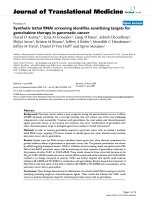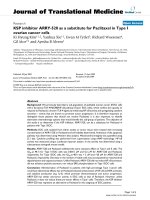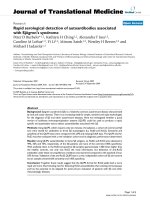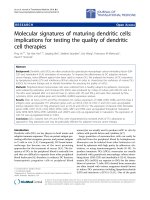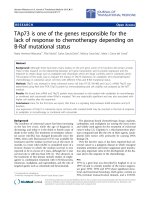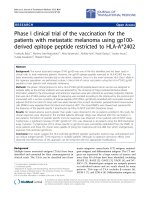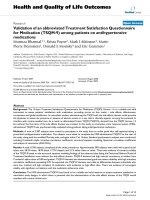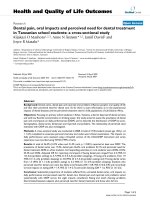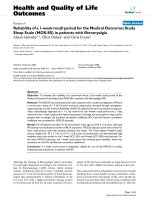Báo cáo hóa học: " Brain-Computer Interface Controlled Functional Electrical Stimulation System for Ankle Movement" doc
Bạn đang xem bản rút gọn của tài liệu. Xem và tải ngay bản đầy đủ của tài liệu tại đây (2.48 MB, 14 trang )
RESEARCH Open Access
Brain-Computer Interface Controlled Functional
Electrical Stimulation System for Ankle Movement
An H Do
1,2*
, Po T Wang
3
, Christine E King
3
, Ahmad Abiri
4
and Zoran Nenadic
3,4*
Abstract
Background: Many neurological conditions, such as stroke, spinal cord injury, and traumatic brain injury, can cause
chronic gait function impairment due to foot-drop. Current physiotherapy techniques provide only a limited
degree of motor function recover y in these individuals, and therefore novel therapies are needed. Brain-compu ter
interface (BCI) is a relatively novel technology with a potential to restore, substitute, or augment lost motor
behaviors in patients with neurological injuries. Here, we describe the first successful integration of a noninvasive
electroencephalogra m (EEG)-based BCI with a noninvasive functional electrical stimulation (FES) system that
enables the direct brain control of foot dorsiflexion in able-bodied individuals.
Methods: A noninvasive EEG-based BCI system was integrated with a noninvasive FES system for foot dorsiflexion.
Subjects underwent computer-cued epochs of repetitive foot dorsiflexion and idling while their EEG signals were
recorded and stored for offline analysis. The analysis generated a prediction model that allowed EEG data to be
analyzed and classified in real time during online BCI operation. The real-time online performance of the integrated
BCI-FES system was tested in a group of five able-bodied subjects who used repetitive foot dorsiflexion to elicit
BCI-FES mediated dorsiflexion of the contralateral foot.
Results: Five able-bodied subjects performed 10 alternations of idling and repetitive foot dorsifiexion to trigger
BCI-FES mediated dorsifiexion of the contralateral foot. The epochs of BCI-FES mediated foot dorsifiexion were
highly correlated with the epochs of voluntary foot dorsifiexion (correlation coefficient ranged between 0.59 and
0.77) with latencies ranging from 1.4 sec to 3.1 sec. In addition, all subjects achieved a 100% BCI-FES response (no
omissions), and one subject had a single false alarm.
Conclusions: This study suggests that the integration of a noninv asive BCI with a lower-extremity FES system is
feasible. With additional modifications, the proposed BCI-FES system may offer a novel and effec tive therapy in the
neuro-rehabilitation of individuals with lower extremity paralysis due to neurological injuries.
Background
Many neurological conditions, such a s stroke, spinal
cord injury (SCI), and traumatic brain injury (TBI), can
leave the affected individual with severe or complete
paralysis. There are currently no biomedical treatments
available that can reverse the loss of motor function
after these neurological injuries [1], and p hysiotherapy
typically provides only a limited degree of motor func-
tion recovery [2-4]. Brain-computer interface (BCI) is a
relatively novel technology with the potential to restore,
substitute, or augment lost motor behaviors in patients
with devastating neurological conditions such as high-
cervical SCI or amyotrophic lateral sclerosis [5-8]. For
example, BCIs systems have enabled direct brain control
of applications such as computer cursors [8], virtual
keyboards [9,10], a nd movement within virtual reality
environments [11-13]. Most notably, BCIs have enabled
the direct brain control of limb prosthetic devices [7,14],
and such BCI-co ntrolled prostheses represe nt a promis-
ing neuro-rehabilitative technology for motor function
restoration in the neurologically injured. In the future,
they may provide a permanent solution for restoration
of lost motor functions, especially if no equivalent bio-
medical treatment exists.
* Correspondence: ;
1
Department of Neurology, University of California, Irvine, CA 92697 USA
3
Department of Biomedical Engineering, University of California, Irvine, CA
92697 USA
Full list of author information is available at the end of the article
Do et al. Journal of NeuroEngineering and Rehabilitation 2011, 8:49
/>JNER
JOURNAL OF NEUROENGINEERING
AND REHABILITATION
© 2011 Do et al; licensee BioMed Central Ltd. This is an Open Access article distributed under the terms of the Creative Commons
Attribution License ( which permits unrestricted us e, distribution, and reproduction in
any medium, pro vided the original work is properly cited.
Generally, BCI control of a limb prosthesis is accom-
plished by acquiring neurophysiological signals asso-
ciated with a motor process, analyzing these signals in
real time, and subsequently translating them into c om-
mands for a limb prosthesis. To date, this concept has
been su cces sfully applied to the control of robotic arms
[15] and functional electrical stimulation (FES) devices
of the upp er extremities [7,14]. More specific ally, Hoch-
berg et al. [15] demonstrated how a subject with tetra-
plegia due to SCI could use an invasive BCI to operate a
robotic arm to perform a simple task of moving an
object from one point to ano ther and t o open and close
a robotic hand. Also, Pfurtscheller’sgroup[7,14]
demonstrated how an individual affected by tetraplegia
due to SCI was able to utilize a noninvasive electroence-
phalogram (EEG)-based BCI to control hand grasping
viaFEStocompleteagoal-oriented task of grasping an
object and moving it another location.
In spite of e ncouraging results a chieved with upper
extremity BCI-FES systems, the integration of BCI with
lower extremity FES systems has received less atten tion.
At the time of this publication, review of the literature
revealed that no actual BCI-FES systems for the lower
extremities have been reported on. This may be partly
explained through historical reasons, as BCI system
development has been primarily focused on individuals
with severe paralysis, such as those with locked-in syn-
drome or high cervical SCI [16]. These individuals
would most likely benefit from using BCI technology
tha t res tores communication and upper extremi ty func-
tion for interactio n with th e environment. Meanwhile,
wheeled mobility has generally been considered an effec-
tive and robust method of substitution for ambulation in
lower extremity paralysis. Finally, in the context of EEG-
based BCIs, lower extremity movements, such as ambu-
lation, may cause significant artifacts which in turn may
require the use of specialized EEG systems (e.g. active
or actively shielded electrodes), thus creating a research
barrier for laboratories without this technology.
Focusing the development of BCI technology on indi-
viduals with complete pa ralysis due to neurological
injury significantly limits it s application domain.
Recently, BCI-FES systems are i ncreasingly being
explored as potential neuro-rehabilitation tools for
improving partially impaired upper extremity function
in individuals with stroke [17], thereby vastly broadening
the potential target populati on. Given that an estimated
36% of stroke patients [4], 68% of SCI patients [ 18,19],
and 61% of TBI patients [20] are affected by significant
chronic gait impairment, there i s a compelling need for
the development of BCI-FES system for the lower extre-
mities. Furthermore, the development of such a system
may facilitate neural plasticity and repair mechanisms to
improve impaired lower extremity and gait functions in
these patient populations. This will not only further
broaden the application domain of BCI technology, but
will also yield a novel neuro-rehabilitation approach to
some of the most prevalent neurological injuries. As the
initial step towards achieving this goal, we describe the
first integration of a noninvasive EEG-based BCI with a
noninvasive FES system that enables the direct brain
control of foot dorsifiexion. The performance of the sys-
tem was tested in a small group of able-bo died subjects
who were able to use repetitive foot dorsifiexion to elicit
BCI-FES mediated dorsifiexion of the contralateral foot.
Methods
Overview
The goal of this study is to integrate a noninvasive EEG-
based BCI system with a noninvasive FES system for the
lower extremities. The schematic diagram of the overall
system is shown in Figure 1A. The proposed system uti-
lizes a contralaterally-controlled FES paradigm [21],
wherein healthy subjects perform repetitive foot dorsi-
fiexion, EEG patterns underlying this action are detected
in real time, and this information is subsequently used
to trigger FES of the tibialis anterior (TA) muscle of the
contralateral foot so as t o achieve its dorsifiexion. The
study entails a training procedure, w here preliminary
EEG data is collected and a subject-specific prediction
model is designed, followed by an online session, where
the real-time performance of the integrated BCI-FES
system is tested.
Recruitment
The study wa s approved by the Institutional Review
Board of the University of California, Irvine. Since the
present work represents a proof-of-principle study, it
was aimed at able-bodied subjects who are generally
healthy with no history of neurological conditions. Five
subjects were recruited and provided their informed
consent to participate in the study. Their demographic
data are shown in Table 1.
Signal Acquisition
An actively-shielded EEG cap (MediFactory BV, Heerlen,
the Netherlands) with 64 sintered Ag-AgCl electrodes,
arranged according to the 10-20 International Standard,
was used for EEG recording (see Figure 1B). Conductive
gel (Compumedics USA, Charlotte, NC) was applied to
all electrodes and the 30-Hz impedances between each
electrode and the reference electrode were maintained at
<10 Ω by abrading the scalp with a blunt needle. The
EEG signals were amplified, band-pass f iltered (0.01-50
Hz), digitized (sampling rate: 256 Hz, resolution: 22 bits),
and acquired in a common average reference mode using
two linked 32-channel bioamplifiers (NeXus-32, Mind
Media, Roermond-Herten, the Netherlands). A pair of
Do et al. Journal of NeuroEngineering and Rehabilitation 2011, 8:49
/>Page 2 of 14
custom-made electrogoniometers [22] were mounted
onto the anterior surface of each ankle and were used to
measurefootdorsifiexion(seeFigure1B).Thegoni-
ometer traces were acquired by a data acquisition system
(MP150, Biopac Systems, Goleta, CA) with a sampling
rate of 4 kHz and a resolution of 16 bits. Both the data
acquisition and experimental protocols were controlled
by custom-made Matlab (Mathworks, Natick, MA)
scripts. EEG data recorded during training procedures
were saved for offline analysis, while those recorded
Figure 1 Integra ted BCI-FES system. (A) Block diagram of the integrated BCI-FES system.Inresponsetovisualcues,thesubjectperforms
actions (idling or dorsifiexion), the underlying EEG data are analyzed by a BCI computer, and instructions are sent to a microcontroller unit
(MCU). The MCU controls an FES system that sends feedback to the subject by means of stimulation. (B) Experimental setup showing the subject
performing right foot dorsifiexion in response to visual cues displayed on the computer screen. EEG signals underlying this activity are recorded
by the EEG cap and sent to the bioamplifier, and then to the BCI computer for analysis. The computer sends commands to a commercial Food
& Drug Administration (FDA) approved FES device by means of the MCU. The FES device then stimulates the TA muscle of the foot, thereby
causing contralateral dorsifiexion. The inset shows the MCU connected to the neuromuscular stimulator and the placement of surface FES
electrodes. Also visible is a pair of custom-made electrogoniometers [22], used for measurement of both executed and BCI-FES mediated foot
dorsifiexion.
Do et al. Journal of NeuroEngineering and Rehabilitation 2011, 8:49
/>Page 3 of 14
during online sessions were analyzed in real time (see
below).
Training Procedure
To achieve BCI control of the FES device and in turn
control foot dorsifiexion, the BCI system must be able
to reliably decode EEG signals associated with either
foot dorsifiexion or idling.Tothisend,aprediction
model was synthesized by first recording EEG signals
during alternating epochs of foot dorsifiexion and idling.
More specifically, each subject was seated in a chair,
approximately 0.8 to 1 m from a computer monit or,
which displayed instruction al cues during all experimen-
tal procedures (see Figure 1B). Subjects were then
instructed to alternate between 6-sec epochs of idling
and repeated foot dorsifiexion. The frequency of dorsi-
fiexion was determined by the subject and ranged
between 6 and 9 dorsifiexion cycles per 6-sec epoch
(1.0-1.5 Hz). A total of 200 epochs (100 epochs per
class) were performed, with the procedure lasting
approximately 20 min. Finally, the above training proce-
dure was repeated u sing the opposite foot and the foot
that yielded the prediction model with the highest clas-
sifica tion accuracy (see Offline Si gnal Analysis and Pre-
diction Model Generation section below) was chosen to
continue with the remainder of the study.
Offline Signal Analysis and Prediction Model Generation
Channels whose EEG signals were excessively contami-
nated by electromyogram (EMG) artifacts were excluded
from analysis. To this end, an iterati ve artifact rejection
algorithm was used, where channels whose EEG ampli-
tude exceeded an outlier voltage threshold in more than
25% of the total trials were removed. The outlier thresh-
old was nominally set to 6 standard deviations (SD)
from the mean, and was adaptively changed to keep the
number of outlier trials below a pre-specified number
(5% of all trials in the present study). The above proce-
dure was repeated until no more channels could b e
removed. To minimize the effect of outliers on statistical
estimates, robust (i.e. median-based) mean and standard
deviation were used [23]. The above procedure typically
resulted in the exclusion of signals from circumf erent ial
“hat band” electrodes which usually overlay the masto id
process, the forehead, the occiput, and the temporalis
muscles. Upon artifact removal, a continuous 20-min
EEG record was split into 100 idle and 100 dorsifiexion
trials based on the corresponding electrogoniometer sig-
nals recorded simultaneously with EEG during the train-
ing procedure. Each EEG trial (~6 sec) was then
transformed i nto the frequency domain using the Fast
Fourier Transform (FFT), and its power spectral density
wasintegratedin2Hzbinscenteredat1,3,5,···,49
Hz. This resulted in 25 binned power spectral values
per channel. A frequency search was then performed to
find the best contiguous frequency range for classifica-
tion. Initially, the full range of frequencies (0.01-50 Hz)
was used, resulting in a 25 × C dimensional data matrix,
where C is the number of retained EEG channels (C
ranged between 44 and 46 across all subjects). To facili-
tate subsequent classification, the dimension of input
data was reduced using a combination of classwise prin-
cipal component analysis (CPCA) [24,25] and approxi-
mate information discriminant analysis (AIDA) [26].
This resulted in the extraction of one-dimensional (1D)
spatio-spectral features:
f = T
A
C
(
d
)
(1)
where d Î ℝ
25×C
is single-trial EEG data, F
C
: ℝ
25×C
®
ℝ
m
is a piecewise linear mapping from the data space
into an m-dimensional CPCA-subspace, and T
A
: ℝ
m
®
ℝ is an AIDA transformation matrix. A detailed descrip-
tion of CPCA, AIDA, and a related information-theoretic
feature extraction technique can be found in [25-27],
respectively. A linear Bayesian classifier:
P(I |f)
P(D|f )
I
>
<
D
1
(2)
was then designed in the feature domain, where
P
(
I|f
)
and
P
(
D|f
)
are the posterior probabilities
1
of idling and
dorsifiexion classes, respectively. Equation (2) is read as:
“classify f
⋆
as idling class if
P
(
I|f
)
> P
(
D|f
)
,andvice
versa.” The performance of the Bayesian classifier (2),
expressed as classification accuracy, was then assessed by
performing 5 runs of a stratified 10-fold cross-validation
[28].
The lower bound of t he frequency range was then
increased in 2-Hz steps, and the above procedure was
repeated until the c lassifier performance stopped
improving. This defined the optimal lower frequency
bound, F
L
.OnceF
L
was found, the optimal higher fre-
quency bound, F
H
, was found in a similar manner. The
parameters of the prediction model, including the
Table 1 Population Demographics
Subject Sex Age (yr) Dominant Side BCI Experience (hr)
1 F 24 L 20
2 M 40 R 10
3M29 R 5
4M28 R 0
5F56 R 5
The demographics of five able-bodied subjects. The columns list: subject
number, sex, age, dominant side (L-left, R-right), and number of hours of
relevant BCI experience.
Do et al. Journal of NeuroEngineering and Rehabilitation 2011, 8:49
/>Page 4 of 14
optimal frequency range, the feature extraction mapping,
and the classifier parameters, were then saved for real-
time EEG analysis necessary for online BCI-FES opera-
tion.Finally,thesignalprocessing,featureextraction,
and classificatio n algorithms were implemented into the
BCI software for real-time operation.
Online Signal Analysis
During online operation, 0.5 sec segments of EEG data
were acquired in real time at a frequency of two non-
overlapping segments per second. The EEG data seg-
ments were then processe d as described in the previous
section. Briefly, the EEG signals were band-pass filtered
and the data from the artifact prone channels were
removed. The remaining data were transformed into the
frequency domain by FFT, and the power spectral densi-
ties (over the optimal frequency range) were calculated.
The spectral data were then used as an input for the
feature e xtraction a lgorithm, which r esulted in the
extraction of 1D spatio-spectral features. The posterior
probabilitie s of i dling and do rs ifiex ion classes given the
observed EEG features, were then calculated as
described in the previous section.
BCI-FES Integration
A low-cost, FDA-approved, constant-curre nt neuromus-
cular stimulator (LG-7000, LG Medical Supplies, Austin,
TX) was used for functional electrical stimulation of the
neuromuscular system consisting of the deep peroneal
nerve and the TA muscle (see Figure 1B). To facilitate
BCI-FES integration, the stimulator’s manually con-
trolled “on/off” switch and analog potentiometer that
adjusted the amplitude of the stimulating current had to
be modified to allow computer control of the stimulator
(seeFigure2).Tothisend,theFESdevice’sanalog
potentiometer was rep laced with a digital potentiometer
byutilizingaGeneralPinInputOutput(GPIO)inter-
face. Likewise, the switch function was emulated by
using a digital relay that kept the stimulating circuit
closed/openwhenelectricalstimulationwas/wasnot
intended. Both the digital potentiometer and the relay
were controlled by a microcontroller unit (Freescale
M52259, Freescale Semiconductors, Austin, TX) in a
master-slave configuration. More specifically, a custom-
made C-language program was used to instruct the
microcontroller unit (MCU ) to listen for command
requests from the BCI computer via a DB9 serial port,
utilizing a universal asynchronous receiver/transmitter
protocol. These requests carried the information on
whether to turn the stimulator “on” or “off” (as deter-
mined by the prediction model), and the intensity of
electrical stimulation (as determined by the experimen-
ter). Based on the current relay and potentiometer
states, the MCU generated the a ppropriate signals
needed to achieve the desired result. For example, when
real-time EEG data were classified as “dorsifiexion,” the
BCI software sent a series of instructions to the MCU
that commanded the relay to close the stimulation cir-
cuit and the digital potentiometer to decrease its resis-
tance, thereby initiating electrical stimulation. This
continued until the real-time EEG data were decoded as
“idle,” upon which the BCI software sent a series of
instructions to the MCU to open the relay, thereby
opening the stimulation circuit and st opping the electri-
cal stimulation. During operation, the BCI-FES system
toggled between these two states.
Calibration
Prior to online BCI operation, a brief calibration proce-
dure was performed to d etermine the posterior prob-
ability thresholds for optimal online BCI-FES operation
so that the number of false state transitions is mini-
mized. Using the prediction model based on the training
data, the BCI-FES sy stem was set to run in the online
mode without FES stimulation. Subjects were prompted
to alternate between 20-sec epochs of idling and repeti-
tive foot dorsifiexion for a total of 3 min. Meanwhile,
real-time EEG signal analysis was performed, and the
posterior probabilities of dorsifiexion and idling given
data,
P
(
D|f
)
and
P
(
I|f
)
, were calculated every 0.5 sec,
as described in Online Signal Analysis section. The dis-
tributions of the posterior probabilities,
P
(
D|f
∈ I
)
and
P
(
D|f
∈ D
)
, were then empirically estimated as i n
Figure 3. Since the BCI-FES system is a binary state
machine, two thresholds were chosen from the histo-
grams–one to trigger the transitions from “idle” to “dor-
sifiexion” state
(
T
1
=medianP
(
D|f
∈ D
))
, and another
for the transitions from “dorsifiexion” to “idle ” state
(
T
2
=medianP
(
D|f
∈ I
))
. During online BCI opera-
tion, the posterior probabilities
P
(
D|f
)
were averaged
over a 1.5 sec period, and the average probabilities
¯
P
(
D| f
)
were compared to the thresholds T
1
and T
2
.
Depending on the present state, the transitions of the
BCI-FES system were governed by the rules as illu-
strated by the state-machine diagram in Figure 4.
Online BCI-FES Evaluation
Experimental Procedure
To evaluate the performance of the BCI-FES dorsifiex-
ion system, subjects engaged in a contralaterally-
controlled FES paradigm, similar to that described in
[21]. FES preparation included the application of self-
adhesive surface electrodes to the skin over the anterior
lateral lower leg, covering the approximate course of the
deep peroneal nerve, as illustrated in Figure 1B. Test
stimulation was used to confirm that the electrode
placement and chosen stimulation parameters were
adequate for effective foot dorsifiexion (~15° to 20°). The
Do et al. Journal of NeuroEngineering and Rehabilitation 2011, 8:49
/>Page 5 of 14
Figure 2 BCI-FES control module. (A) The block diagram shows a microcontroller unit (MCU) interfaced with a digital potentiometer (digipot)
and a relay. The digipot modulates the amplitude of the stimulating current, while the relay keeps the circuit between the surface FES
electrodes and the stimulator normally open. The relay circuit closes when it receives a logical high from the MCU (coinciding with the
detection of dorsifiexion state by the BCI computer). For safety reasons, a manually operated emergency power-off (EPO) switch is added to the
stimulator power supply circuit. (B) The circuit diagram of the BCI-FES control module showing detailed wiring scheme. The digipot’s resistance
changes from 0 kΩ to 50 kΩ, thereby changing the amplitude of the stimulating current from 0 mA to 100 mA. Not shown in (A) is a field-effect
transistor (BS170), used to ensure proper power-on sequence for the digipot.
Do et al. Journal of NeuroEngineering and Rehabilitation 2011, 8:49
/>Page 6 of 14
stimulation parameters, including current amplitude,
pulse width, and frequency, were empirically determined
to achieve the required foot dorsifiexion without causing
discomfort to the subject.
To ascertain purposeful control of the BCI-FES sys-
tem, subjects performed ten alternating 10-sec epochs of
idling and repetitive dorsifiexion of the optimally chosen
foot (see Training Procedure section) to induce BCI-FES
mediated dorsifiexion of the contralateral foot. Since th e
present study focused on able-bodied subjects, an ipsi-
laterally controlled FES paradigm was not used due to
the inability to resolve voluntary and BCI-FES mediated
dorsifiexion. Instructions to perform this task were
shown as textual cues on the computer screen. Both
voluntary and BCI-FES mediated foot dorsifiexion were
measured by electrogoniometers.
Performance Analysis
The analysis of online BCI-FES operation was performed
by comparing the epochs of voluntary and BCI-FES
mediated foot dorsifiexion. For this purpose, the read-
ings from the two electrogoniometers (see Figure 1)
were first smoothed by a 100-msec Gaussian window,
and epochs of foot dorsifiexion and idling were deter-
mined by a threshold crossing. A time series, x,describ-
ing voluntary foot dorsifiexion was then defined as:
x[i]=
0, if i ∈
I
1, if i ∈ D
(3)
where i =1,2,···,N, and N is the number of samples
in the goniometer trace. A time series, y,describing
BCI-FES mediated foot dorsifiexion, was defined in a
similar manner. The normalized cross-covariance func-
tion between the time series x and y was then calculated
as:
ρ(m)=
N
i=1
(x[i + m] −
¯
x)(y[i] −
¯
y)
N
i=1
(x[i] −
¯
x)
2
N
i=1
(y[i] −
¯
y)
2
(4)
where m Î [-N +1,N-1] is the lag between the
sequences x and y, and
¯
x
and
¯
y
are the sample means of
the two sequences, respe ctively. The latency between
voluntary and BCI-FES mediated foot dorsifiexion was
then found as the lag with maximal cross-covariance, i.e.
m
⋆
= arg max
m
r(m). Subsequently, the temporal corre-
lation between x and y was found to be : r
⋆
= r(m
⋆
). In
addition, the absence of a BCI-F ES mediated foot dorsi-
fiexion epoch initiated within the duration of any volun-
tary foot dorsifiexion epoch was considered an omission.
Finally, the initiation of a BCI-FES mediated foot dorsi-
fiexion epoch within any idling epoch was considered a
false alarm.
Results and Discussion
Results
Offline Performance
Each subject underwent training data collection as
described in the Methods section. The EEG data asso-
ciated with epochs of idling and repetitive foot dorsifiex-
ion were analyzed and classified using the prediction
model generated from this analysis. The input data for
the prediction model were the powers of multi-channel
EEG signals calculated in 2-Hz bins. The optimal sub-
ject-specific EEG frequency bands (see Table 2) were
found using the procedure described in the Methods
secti on, and included the μ (8-13 Hz), b (13-30 Hz) and
low-g (30-38 Hz) bands for Subject 1, high-b (22-30 Hz)
and low-g (30-50 Hz) bands for Subject 2, μ, b and low-
g (30-50 Hz) bands for Subject 3, μ and b bands for
Subject 4, a nd μ, b and low-g (30-50 Hz) ba nds for
Subject 5.
The offline performance was evaluated by performing
10-fold cross-validation, and a classification accuracy
Figure 3 Histograms of the posterior class probabilities for
subject B. Based on the known underlying action (idling or
dorsifiexion), the distributions of the posterior probabilities,
P
(
D|f
∈ I
)
and
P
(
D|f
∈ D
)
, are empirically estimated as
histograms. Dashed lines indicate the 25%, 50%, and 75% quartiles,
where the 25% and 50% quartiles for
P
(
D|f
∈ I
)
overlap. Note
that
P
(
D|f
∈ I
)
=1− P
(
I|f
∈ I
)
.
Figure 4 Fin ite state machi ne diagram of the online BCI-FES
system operation. The BCI-FES system is a binary state machine
with idling and dorsifiexion states represented by circles. The state
transitions are represented by the arrows, with transitions triggered
by the conditions shown next to the arrows. The transitions are
executed every 0.5 sec. Self-pointing arrows denote that the system
remains in the present state.
Do et al. Journal of NeuroEngineering and Rehabilitation 2011, 8:49
/>Page 7 of 14
ranging from 85.1% to 97.6% was achieved (see Table 2).
These results are statistically significant, as the probabil-
ity of achieving the performance ≥ 85%, i.e. correctly
classifying 170 or more trials (out of 200) by random
chance, is only 3.0866 × 10
-25
. Note that cross-validation
provides a safeguard against prediction model overfitting
by ensuring that classification accuracy observed offline
generalizes to future online sessions.
Analysis of subject-specific prediction models demon-
strated that the EEG power changes in the b-band
obs erved ov er mid-central areas (i.e. electrode Cz ) were
the most informative features for classification (see Figure
5). These findings were confirmed by examining the
power spectrum of EEG signals at Cz under both idling
and dorsifie xion cond itions (see Figure 6), where a pro-
minent event-related desynchronization (loss of power)
was observed over a broad frequency band. These
observations are consistent with prior studies, where
similar event-related desynchronization was observed
upon initiation or imagination of movement [29-31].
Online BCI-FES Performance
Surface electrode placement for effective FES-induced
dorsifiexion was confirmed prior to online BCI evalua-
tion for all subjects. In general, stimulation parameters
depend on skin impedance, muscle mass, and the sub-
jects’ electrical stimulation tolerance, and were therefore
chosen empirically for each subject while ensuring that
~15°-20° of foot dorsifiexion was achieved. The subject-
specific stimulation parameters are summarized in Table
2. In addition, prior to online BCI-FES evaluation, a test
FES p rocedure was performed and no FES interference
was visible on the EEG signals.
During online BCI-FES operation, each subject
performed repetitive dorsifiexion of their optimally
Table 2 Overall Performances
Subject Foot EEG-band (Hz) Classification Accuracy Current (mA) Pulse Width (μsec) Frequency (Hz) Lag (sec) r
⋆
OM FA
1 R [8-38] 94.4% 100 140 20 3.1 0.67 0 0
2 L [22-50] 97.6% 100 200 30 1.4 0.72 0 0
3 L [8-50] 85.1% 90 200 30 2.7 0.59 0 1
4 R [8-30] 91.9% 88 200 20 3.0 0.62 0 0
5 R [10-50] 93.6% 100 120 20 2.9 0.77 0 0
The performances of five subjects. The columns list: the foot that was voluntarily dorsiflexed, the EEG frequency band that was used for classification, (offline)
classification accuracy as established by 10-fold cross-validation, the stimulating current amplitude, its pulse width and frequency, (online) lag between voluntary
and BCI-FES-mediated dorsifiexion epochs, temporal correlation between these epochs (r
⋆
) calculated at the corresponding lags, omissions (OM), and false alarms
(FA).
Figure 5 Topographic distribution of spect ral features. Feature extraction mappin g at high-b band (two-Hz bin centered at 29 Hz) for
subject B. Values close to +1 and -1 indicate brain areas of importance for classifying EEG data into idling and dorsifiexion classes. Since our
feature extraction mapping is piecewise linear, there are two maps; one adapted to idling class (left) and one adapted to dorsifiexion class
(right). Note that both maps feature the area around the Cz-electrode as prominent, indicating the importance of this brain area at this particular
frequency for distinguishing between idling and foot dorsifiexion.
Do et al. Journal of NeuroEngineering and Rehabilitation 2011, 8:49
/>Page 8 of 14
chosen foot to induce BCI-FE S-medi ated dorsifiexion of
the contralateral foot. More specifically, each 0.5 sec
segment of EEG data was acquired and analyzed as
explained in the Metho ds section, and based on this
analysis, the computer instructe d the FES system to
respond. The basic steps of this procedure applied to
the training data are illustrated in Figure 7.
The online performances are quantified by four cri-
teria: (i) lag between a ctual and BCI-FES-mediated dor-
sifiexion epochs, (ii) temporal correlation (at the
corresponding lag value) between these epochs, (iii)
number of omissions, and (iv) number of false alarms.
Figure 8 shows the best online session for Subject 2.
All subjects performed the task with no omissions
(100% BCI-FES response). However, BCI-FES-mediated
dorsifiexion epochs ty pically lag behind the actual dorsi-
fiexion epochs, and the average values of this latency
ranged from 1.4 sec to 3.1 sec across all subjects (see
Table 2). Temporal correlations between the voluntary
and BCI-FES-mediated dorsifiexion epochs ranged
between 0.59 and 0.77, and are also shown in Table 2.
The statistical significance of these results was con-
firmed by running 10,000 Monte Carlo simulation trials
with a chance level classification accuracy (50%). The
maximum correlation coefficient obtained from the
simulation was 0.41, and therefore even the lowest
correlation coefficient of 0.59 is significant with a
p-value <10
-4
.
The correlation c oefficient measures the temporal
consistency between voluntary foot dorsifiexion and the
corresponding BCI-FES-mediated dorsifiex ion response.
Note that its value is normalized between -1 and 1, and
appears to correlate with offline accuracy. For example,
Subjects 2 and 5, who achieved the highest offline classi-
fication accuracy, also had the highest correlation coeffi-
cients. Conversely, Subject 3 achieved the lowest
classiffication accuracy and correlation coefficient. This
drop in online p erformance may be attributed to a sin-
gle false alarm (see Table 2). Subjects 1, 2, 4 and 5, o n
the other hand, had no false alarms.
Discussion
This study reports on the first successful integration of a
noninvasi ve EEG-based BCI with a noninvasive FES sys-
tem for the lower extremities. The performance of the
integrated BCI-FES system was tested in a population of
five able-bodied subjects, utilizing a contralaterally-con-
trolled FES paradigm [21] where subjects performed
repetitive dorsifiexion of their optimally chosen foot to
trigger BCI-FES-mediated dorsifiexion of the contralateral
foot. This paradigm was chosen since ipsilateral dorsifiex-
ion and stimulation in able-bodied subjects would pro-
duce confounding results, as it would be difficult to
resolve voluntary and BCI-FES-induced movements.
During the training procedures, the subjects were
instructed to refrain from excessive face, mouth and eye
movements. However, natural movements associated
with normal seated behavior (eye blinks, swallowing,
small eye and facial movements) were permitted. Note
that these movements are not expected to cause any
systematic error as l ong as they are not synchronized
with either dorsifiexion or idling. To support this claim,
Subject 4 was also fitted with electrooculogram (EOG)
and EMG electrodes for simultaneous recording of eye
and facial muscle movements during the training proce-
dure. Analogous to EEG data, EMG/EOG d ata were
used to design a prediction model. The performance of
this classifier was 53%, which was not statistically differ-
ent (p-value: 0.22) from the chance leve l performance
(50%). In summary, since idling and dorsifiexion could
not be predicted from EMG/EOG signals, it is thus
extremely unlikely that EEG was contaminated by EOG/
EMG artifacts in a systematic manner. Finally, the active
shielding feature of our EEG system minimized the elec-
tromagnetic interference due to cable movements and
mechanical vibrations.
Offline analysis of EE G signals corresponding to
epochs of repetitive foot dorsifiexion and idling collected
Figure 6 Power spectral density at electrode Cz. A broadband
(8-50 Hz) desynchronization of EEG signals at electrode Cz for
subject B. Red and blue traces denote the average (n = 100) power
spectra of EEG signals under idling and foot dorsifiexion conditions,
respectively. The shades represent ±1 SEM (standard error of mean)
bounds. Black trace represents the signal-to-noise ratio (SNR),
defined as in [36]:
S
NR(f )=
(μ
i
(f )−μ
d
(f ))
2
σ
2
i
(f )+σ
2
d
(f )
, where f is the
frequency, μ
i
(f) and μ
d
(f) are the average powers at the frequency f
under idling and dorsifiexion conditions, respectively, and
σ
2
i
(f
)
and
σ
2
d
(f
)
are the corresponding variances. The values of SNR
above the magenta line define the frequencies with statistically
significant difference between μ
i
(f) and μ
d
(f)(p<0.01, paired t-test).
Do et al. Journal of NeuroEngineering and Rehabilitation 2011, 8:49
/>Page 9 of 14
during the training p rocedures revealed that the EEG
power in the μ, b and low-g bands were responsible for
encoding the differences between idling and dorsifiexion
states. The change in the signal power was mostly
observed over the mid-central area, which likely corre-
sponds to activity within the primary motor cortex’s
foot representation area (located in the interhemispheric
fissure of the brain) and/or supplementary motor area.
This was further confirmed by examining the feature
extraction maps of the prediction models (see Figure 5),
which indicated that mid-central brain areas played a
prominent role in classifying idling and dorsifiexion
states. While these results are not surprising from a
brain anatomy standpoint, it should be noted that our
prediction model is entirely data driven, and so these
observations underscore the physiological and
anatomical plausibility of ou r feature extraction map. It
should also be noted that these spatio-spectral EEG sig-
nal features are consistent with prior studies [29,30].
Consequently, idling and dorsifiexion epochs could be
predicted from the underlying multi-channel EEG data
with an accuracy as high as 97.6%, and all subjects
achieved performances that were significantly above ran-
dom chance.
The results achieved online demonstrate that BCI-
FES-mediated foot dorsifiexion can be reliably controlled
using a contralateral control paradigm in a small popu-
lation of able-bodied individuals. In general, this study
suggests that the integration of a noninvasive BCI with a
lower-extremity FES system is feasible. In a ddition to
achieving excellent performances, all subjects were able
to assume immediate control of the interface, requiring
Figure 7 Online EEG classification illustrated on training data. (A) A goniometer trace delineating id ling and dorsifiexion states. ( B) The
corresponding EEG signal trace recorded at the Cz electrode. (C),(D) One-dimensional spatio-spectral EEG features extracted using Eq. (1) shown
in the subspaces corresponding idling
(
I
)
and dorsifiexion
(
D
)
states, respectively. The pink and green bands represent the mean ± 2 standard
deviations (SD) of features corresponding to idling and dorsifiexion training data, respectively. (E) The average posterior probability of dorsifiexion
given feature, f
⋆
. Dashed lines correspond to the thresholds, T
1
(green) and T
2
(red) as determined in the Calibration section. As outlined in Fig.
4, when the average posterior probability
¯
P
(
D| f
)
> T
1
, the BCI-FES system transitions to dorsifiexion state (shown as green block).
Conversely, when
¯
P
(
D| f
)
> T
2
, the BCI-FES system transitions to idling state (pink block).
Do et al. Journal of NeuroEngineering and Rehabilitation 2011, 8:49
/>Page 10 of 14
only a single, short 20 min training session to develop a
pred iction model, and a single 3 min calibration session
(see Methods section). It should be noted that the high
performances achieved offline generally transferred into
robust online BCI-FES operation, indicating that our
cross-validation procedure selec ted the c orrect predic-
tion model without overfitting. It should also be noted
that since the prediction model was designed based on
data largely free of any systematic artifacts, activities
such as teeth clenching, grimacing, and other forms of
“cheating” are likely to be ineffective in the online ses-
sion, since the model was not designed to recognize
them. Similarly, o ther electrophysiological artifacts of
cortical origin (e.g. epileptic discharges) are unlikely to
affect the system’s online perfo rmance . Finally, the FES-
elicited movements during onl ine operation did not
interfere wit h the control of the BCI system. F or exam-
ple, upon cessation of voluntary foot dorsifiexion, it is
conceivable that EEG signals due to FES-elicited move-
ments may be confused w ith those of voluntary move-
ments, which may in turn co nfuse the classifier and
cause the system to remain in the dorsifiexion state.
This type of positive feedback, however, was not
observed, perhaps because the EEG signals underlying
these types of movements were sufficient ly different and
did not get misclassified. These differences may reflect
spatial separation of cortical representations of FES-
induced passive movements (likely lo calized to s ensory
cortex areas) and of voluntary movements (originating
from more anterior brain motor areas).
Future Directions
This BCI-FES dorsifiexion system may be used in a
future seated therapeutic exercise that can facilitate
neuralrepairinstroke,SCI,orTBIpatientswhoare
affected by foot-drop. By pairing activation of motor
Figure 8 Online performances of a representative subject. (A) Blue trace marks the 10 epochs of 10-sec-long repetitive foot dorsifiexion for
Subject 2, and red trace marks the epochs of BCI-FES mediated dorsifiexion of the contralateral foot. (B) The inset of a single dorsifiexion epoch
[dashed box in (A)] showing the goniometer trace corresponding to 15 dorsifiexion cycles (blue) and BCI-FES-mediated dorsifiexion (red).
Do et al. Journal of NeuroEngineering and Rehabilitation 2011, 8:49
/>Page 11 of 14
cortex associated with attempted, but impaired dorsi-
fiexion, with electrica l stimulation o f foot dorsifiexion
motor pools (via antidromic electrical stimulation of the
deep peroneal nerve), it can be hypothesized that spared
connections between th e post injury motor cortex and
the motor pools of foot dorsifiexion will be reinforced
in a Hebbian manner. This hypothesized plasticity pro-
cess associated with BCI-FES use may thereby translate
into the improvement of unassisted dorsifiexion strength
and gait function in this patient population. Since many
patients with stroke, TBI, or SCI may have non-classical
foot motor representatio n due to post-injury reorganiza-
tion, the use of the data-driven method described in the
current work to generate a “personalized ” EEG predic-
tion model for each subject will be of particular
importance.
While the performance of the current system was
tested in a contralaterally-controlled FES paradigm, its
practical application in individuals with paralysis due to
neurological injury will require utilization of an ipsilater-
ally-controlled FES paradigm, whereby attempted move-
ment of the paralyzed limb acts as the control strategy
for its own BCI-FES mediated movement. Addit ional
studies will need to be undertaken in individuals with
foot-drop d ue to central neurological injury in order to
assess the utility of this paradigm.
The hypothesized applicability towards neuro-rehabili-
tation by utilizing an ipsilaterally-controlled FES para-
digm to induce Hebbian neural recovery raises
significant concerns about e liminating the lat ency
between the onset of voluntary movement and BCI-FES
mediated movement. The observed latency is partly
caused by the averaging of posterior probability over 1.5
sec period (see Calibration section) during online opera-
tion. Reducing the averaging window may help decrease
this latency, although perhaps at the expense of lowering
the online p erformance (higher false positive and omis-
sion rates). Note that the observed latency is also consis-
tent with a natural delay of maximal event-related
desynchronization and synchronization of EEG sensori-
motor rhythms [30,32], and it may be partially responsi-
bleforthedelayintheBCI-FESsystemresponse.A
potential solution to this problem may be to use our
data-driven algorithm to search for relevant time
domain EEG features, such as readiness potentials [33].
These slow negat ive potential shifts may be observed as
early as 1 sec before the initiation of a self-paced motor
behavior [33], and they can potentially be used for early
classification of dorsifiexion and idling. Also, a combina-
tion of temporal and spectral features may be used in
the future to eliminate the latency while ensuring high
performance. However, further research is re quired, as
changes in both the training paradigm and signal pro-
cessing methodology will need to be implemented such
that novel EEG features associated with movement
intentions can be reliably detected.
Finally, the ideal BCI-FES system should mimic foot
dorsifiexion in a 1:1 temporal fashion, in which a single
foot dorsifiexion cycle (as opposed to current repetitive
dorsifiexion) t ranslates into a single BCI-FES mediated
dorsifiexion cycle. To achieve this, changes in both the
training paradigm and signal processing methodology
will need to be implemented such that transient EEG
changes associated with foot dorsifiexio n and relaxation
can be reliably detected and utilized to govern the BCI-
FES system’ s state transitions. In summary, all of the
above improvements and revisions would conceivably
result in a more intuitive BCI neuroprosthesis and could
lead to a seated therapeutic foot dorsifiexion exerci se
for individuals who suffer from foot-drop due to a cen-
tral nervous system injury.
Conclusions
The present study demonstrates that the integration of a
noninvasive EEG-based BCI system with a noninvasive
FES system for the lower extremities is feasible. The
integrated BCI-FES system shows that EEG signals can
be used to enable direct brain control of foot dorsifiex-
ion via FES. This furt her suggests that it may be feasible
to utilize BCI-FES systems to restore lost motor func-
tion of the lower extremitie s in patients with neurologi-
cal injury. While the performance of the current system
was tested in a contralaterally-controlled FES paradigm,
its practical application in individuals with paralysis
due to neurological injury will require the ut ilization
of an ipsilaterally-controlled FES paradigm, whereby
attempted movement of the paralyzed limb acts as the
control strategy for its o wn BCI-FES mediated move-
ment. Despite the presence of neurological injury (e.g.
stroke, SCI, or TBI), and regardless of its extent and
location, EEG spatio-spectral signal features discriminat-
ing attempted foot dorsifiexion and resting states are
still expected to be present [34,35] and exploitable for
BCI control by using a data-driven method for g enerat-
ing “personalized” prediction models. If the elimination
of delay and the implementation of a 1:1 attempted ipsi-
lateral-BCI-FES dorsifiexion paradigm are successful,
BCI-FES systems will likely prove useful in the neuro-
rehabilitation of individua ls with lower extremity paraly-
sis due to neurological injury.
Endnotes
1
The conditional probability of event A given event B,
denoted by P(A|B), is the probability of the event A
given that the event B has happened. The p osterior
probability of idling class, denoted by
P
(
I|f
)
,isthe
conditional probability of idling class given that the
value f
⋆
of the feature f was observed. The post erior
Do et al. Journal of NeuroEngineering and Rehabilitation 2011, 8:49
/>Page 12 of 14
probability of dorsi fiexion class,
P
(
D|f
)
,isdefined
similarly.
Acknowledgements
This work was partially supported by the Roman Reed Spinal Cord Injury
Research Fund of California (RR10-281).
The scientific review of the project described was supported by Grant
Number UL1 RR031985 from the National Center for Research Resources
(NCRR), a component of the National Institutes of Health (NIH), and the NIH
Roadmap for Medical Research. Its contents are solely the responsibility of
the authors and do not necessarily represent the official view of NCRR or
NIH. Information on NCRR is available at />Information on Reengineering the Clinical Research Enterprise can be
obtained from .
Author details
1
Department of Neurology, University of California, Irvine, CA 92697 USA.
2
Department of Neurology, Long Beach Veterans Affairs Medical Center,
Long Beach, CA 90822 USA.
3
Department of Biomedical Engineering,
University of California, Irvine, CA 92697 USA.
4
Department of Electrical
Engineering and Computer Science, University of California, Irvine, CA 92697
USA.
Authors’ contributions
AHD conceived the study and the design of the BCI-FES system, oversaw
the experiments, and co-wrote the article. PTW and CEK carried out the
experiments, collected and analyzed data, and proofread the article. PTW
also programmed the brain-computer interface software. AA designed and
implemented the hardware integration between the BCI computer and the
FES system, and programmed the microcontroller. ZN designed the signal
processing, pattern recognition, and classification algorithms, analyzed the
online performance, and co-wrote the article. All authors read and approved
the final manuscript.
Competing interests
The authors declare that they have no competing interests.
Received: 30 January 2011 Accepted: 26 August 2011
Published: 26 August 2011
References
1. Dombovy M: The Evolving Field of Neurorehabilitation. Neurorehabilitation
in Continuum Lifelong Learning in Neurology 2011, 17(3):443-448.
2. Maynard FM, Reynolds GG, Fountain S, Wilmot C, Hamilton R: Neurological
prognosis after traumatic quadriplegia. Three-year experience of
California Regional Spinal Cord Injury Care System. J Neurosurg 1979,
50(5):611-616.
3. Reding MJ, Potes E: Rehabilitation outcome following initial unilateral
hemispheric stroke. Life table analysis approach. Stroke 1988,
19(11):1354-1358.
4. Jorgensen HS, Nakayama H, Raaschou HO, Olsen TS: Recovery of walking
function in stroke patients: the Copenhagen Stroke Study. Arch Phys Med
Rehabil 1995, 76:27-32.
5. Birbaumer N: Breaking the silence: Brain-computer interfaces (BCI) for
communication and motor control. Psychophysiology 2006, 43(6):517-532.
6. Townsend G, Graimann B, Pfurtscheller G: Continuous EEG classification
during motor imagery-simulation of an asynchronous BCI. IEEE
Transactions on Neural Systems and Rehabilitation Engineering 2004,
12(2):258-265.
7. Pfurtscheller G, Müller G, Pfurtscheller J, Gerner H, Rupp R: ’Thought’-
control of functional electrical stimulation to restore hand grasp in a
patient with tetraplegia. Neurosci Lett 2003, 351:33-36.
8. Wolpaw JR, McFarland DJ: Control of a two-dimensional movement
signal by a noninvasive brain-computer interface in humans. Proceedings
of the National Academy of Sciences of the United States of America 2004,
101(51):17849-17854.
9. Birbaumer N, Ghanayim N, Hinterberger T, Iversen I, Kotchoubey B,
Kübler A, Perelmouter J, Taub E, Flor H: A spelling device for the
paralysed. Nature 1999, 398(6725):297-298.
10. Townsend G, LaPallo B, Boulay C, Krusienski D, Frye G, Hauser C,
Schwartz N, Vaughan T, Wolpaw J, Sellers E: A novel P300-based brain-
computer interface stimulus presentation paradigm: moving beyond
rows and columns. Clin Neurophysiol 2010, 121(7):1109-1120.
11. Leeb R, Friedman D, Müller-Putz G, Scherer R, Slater M, Pfurtscheller G: Self-
paced (asynchronous) BCI control of a wheelchair in virtual
environments: a case study with a tetraplegic. Comput Intell Neurosci
2007, 79642.
12. Scherer R, Lee F, Schlogl A, Leeb R, Bischof H, Pfurtscheller G: Toward self-
paced brain-computer communication: navigation through virtual
worlds. IEEE Trans Biomed Eng 2008, 55(2 Pt 1):675-682.
13. Nenadic Z, Wang PT, King CE, Do AH, Chui LA: Asynchronous brain-
computer interface control of ambulation simulator. Soc Neurosci Abstr
2010, 40:294.6.
14. Müller-Putz G, Scherer R, Pfurtscheller G, Rupp R: EEG-based
neuroprosthesis control: a step towards clinical practice.
Neurosci Lett
2005, 382(1-2):169-174.
15.
Hochberg LR, Serruya MD, Friehs GM, Mukand JA, Saleh M, Caplan AH,
Branner A, Chen D, Penn RD, Donoghue JP: Neuronal ensemble control of
prosthetic devices by a human with tetraplegia. Nature 2006,
442(7099):164-171.
16. Wolpaw JR, Birbaumer N, McFarland DJ, Pfurtscheller G, Vaughan TM: Brain-
computer interfaces for communication and control. Clin Neurophysiol
2002, 113(6):767-791.
17. Daly JJ, Cheng R, Rogers J, Litinas K, Hrovat K, Dohring M: Feasibility of a
new application of noninvasive Brain Computer Interface (BCI): a case
study of training for recovery of volitional motor control after stroke. J
Neurol Phys Ther 2009, 33(4):203-211.
18. Waters RL, Adkins RH, Yakura JS, Sie I: Motor and sensory recovery
following incomplete tetraplegia. Arch Phys Med Rehabil 1994,
75(3):306-311.
19. Krawetz P, Nance P: Gait analysis of spinal cord injured subjects: effects
of injury level and spasticity. Arch Phys Med Rehabil 1996, 77(7):635-638.
20. Williams G, Morris ME, Schache A, McCrory PR: Incidence of gait
abnormalities after traumatic brain injury. Arch Phys Med Rehabil 2009,
90(4):587-593.
21. Knutson J, Harley M, Hisel T, Chae J: Improving hand function in stroke
survivors: a pilot study of contralaterally controlled functional electric
stimulation in chronic hemiplegia. Arch Phys Med Rehabil 2007,
88(4):513-520.
22. Wang PT, King CE, Do AH, Nenadic Z: A durable, low-cost
electrogoniometer for dynamic measurement of joint trajectories. Med
Eng Phys 2011, 33(5):546-552.
23. Huber PJ: Robust Statistics New York: Wiley; 1981.
24. Das K, Osechinskiy S, Nenadic Z: A classwise PCA-based recognition of
neural data for brain-computer interfaces. Conf Proc IEEE Eng Med Biol Soc
2007, 2007:6519-6522.
25. Das K, Nenadic Z: An Efficient Discriminant-based Solution for Small
Sample Size Problem. Pattern Recogn 2009, 42(5):857-866.
26. Das K, Nenadic Z: Approximate information discriminant analysis: A
computationally simple heteroscedastic feature extraction technique.
Pattern Recogn 2008, 41(5):1548-1557.
27. Nenadic Z: Information Discriminant Analysis: Feature Extraction with an
Information-Theoretic Objective. IEEE Trans Pattern Anal Mach Intell 2007,
29(8):1394-1407.
28. Kohavi R: A Study of Cross-Validation and Bootstrap for Accuracy
Estimation and Model Selection. Int Joint C Art Int 1995, 1137-1145.
29. Neuper C, Pfurtscheller G:
Post-movement synchronization of beta
rhythms
in the EEG over the cortical foot area in man. Neurosci Lett 1996,
216:17-20.
30. Solis-Escalante T, Müller-Putz G, Pfurtscheller G: Overt foot movement
detection in one single Laplacian EEG derivation. J Neurosci Methods
2008, 175:148-153.
31. Kanoh S, Miyamoto K, Yoshinobu T: Development of Brain-Computer
Interface (BCI) System for Bridging Brain and Computer. In 13th
International Conference on Biomedical Engineering, Volume 23 of IFMBE
Proceedings. Edited by: Magjarevic R, Lim CT, Goh JCH. Springer Berlin
Heidelberg; 2009:2264-2267.
32. Pfurtscheller G, Aranibar A: Evaluation of event-related desynchronization
(ERD) preceding and following voluntary self-paced movement.
Electroencephalogr Clin Neurophysiol 1979, 46(2):138-146.
Do et al. Journal of NeuroEngineering and Rehabilitation 2011, 8:49
/>Page 13 of 14
33. Libet B, Gleason C, Wright E, Pearl D: Time of Conscious Intention to Act
in Relation to Onset of Cerebral Activity (Readiness-Potential). Brain 1983,
106:623-642.
34. Green JB, Bialy Y, Sora E, Ricamato A: High-resolution EEG in poststroke
hemiparesis can identify ipsilateral generators during motor tasks. Stroke
1999, 30(12):2659-2665.
35. Müller-Putz GR, Zimmermann D, Graimann B, Nestinger K, Korisek G,
Pfurtscheller G: Event-related beta EEG-changes during passive and
attempted foot movements in paraplegic patients. Brain Res 2007,
1137:84-91.
36. Kay S: Fundamentals of Statistical Signal Processing. Detection Theory
Englewood Cliffs, NJ: Prentice-Hall; 1998.
doi:10.1186/1743-0003-8-49
Cite this article as: Do et al.: Brain-Computer Interface Controlled
Functional Electrical Stimulation System for Ankle Movement. Journal of
NeuroEngineering and Rehabilitation 2011 8:49.
Submit your next manuscript to BioMed Central
and take full advantage of:
• Convenient online submission
• Thorough peer review
• No space constraints or color figure charges
• Immediate publication on acceptance
• Inclusion in PubMed, CAS, Scopus and Google Scholar
• Research which is freely available for redistribution
Submit your manuscript at
www.biomedcentral.com/submit
Do et al. Journal of NeuroEngineering and Rehabilitation 2011, 8:49
/>Page 14 of 14
